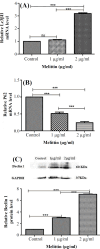Melittin as an Activator of the Autophagy and Unfolded Protein Response Pathways in Colorectal HCT116 Cell Line
- PMID: 38445441
- PMCID: PMC10994640
- DOI: 10.61186/ibj.3993
Melittin as an Activator of the Autophagy and Unfolded Protein Response Pathways in Colorectal HCT116 Cell Line
Abstract
Background: The potential anticancer effect of melittin has motivated scientists to find its exact molecular mechanism of action. There are few data on the effect of melittin on the UPR and autophagy as two critical pathways involved in tumorigenesis of colorectal and drug resistance. This study aimed to investigate the effect of melittin on these pathways in the colorectal cancer (CRC) HCT116 cells.
Methods: MTT method was carried out to assess the cytotoxicity of melittin on the HCT116 cell line for 24, 48, and 72 h. After selecting the optimal concentrations and treatment times, the gene expression of autophagy flux markers (LC3-βII and P62) and UPR markers (CHOP and XBP-1s) were determined using qRT-PCR. The protein level of autophagy initiation marker (Beclin1) was also determined by Western blotting.
Results: MTT assay showed a cytotoxic effect of melittin on the HCT116 cells. The increase in LC3-βII and decrease in P62 mRNA expression levels, along with the elevation in the Beclin1 protein level, indicated the stimulatory role of melittin on the autophagy. Melittin also significantly enhanced the CHOP and XBP-1s expressions at mRNA level, suggesting the positive role of the melittin on the UPR activation.
Conclusion: This study shows that UPR and autophagy can potentially be considered as two key signaling pathways in tumorigenesis, which can be targeted by the BV melittin in the HCT116 cells. Further in vivo evaluations are recommended to verify the obtained results.
Keywords: Bee venom; Colorectal neoplasms; Unfolded protein response; Autophagy.
Conflict of interest statement
The authors declare that they have no competing interests.
Figures



Similar articles
-
The modulation of autophagy and unfolded protein response by ent-kaurenoid derivative CPUK02 in human colorectal cancer cells.Mol Biol Rep. 2024 Apr 30;51(1):599. doi: 10.1007/s11033-024-09541-2. Mol Biol Rep. 2024. PMID: 38689181
-
DUSP4 inhibits autophagic cell death and apoptosis in colorectal cancer by regulating BCL2-Beclin1/Bax signaling.Mol Biol Rep. 2023 Apr;50(4):3229-3239. doi: 10.1007/s11033-023-08270-2. Epub 2023 Jan 27. Mol Biol Rep. 2023. PMID: 36705792
-
The Cytotoxic Effect of Apis mellifera Venom with a Synergistic Potential of Its Two Main Components-Melittin and PLA2-On Colon Cancer HCT116 Cell Lines.Molecules. 2021 Apr 14;26(8):2264. doi: 10.3390/molecules26082264. Molecules. 2021. PMID: 33919706 Free PMC article.
-
New frontiers in the treatment of colorectal cancer: Autophagy and the unfolded protein response as promising targets.Autophagy. 2017 May 4;13(5):781-819. doi: 10.1080/15548627.2017.1290751. Epub 2017 Feb 23. Autophagy. 2017. PMID: 28358273 Free PMC article. Review.
-
Bee Venom Components as Therapeutic Tools against Prostate Cancer.Toxins (Basel). 2021 May 7;13(5):337. doi: 10.3390/toxins13050337. Toxins (Basel). 2021. PMID: 34067049 Free PMC article. Review.
Cited by
-
Melittin Inhibits Colorectal Cancer Growth and Metastasis by Ac-Tivating the Mitochondrial Apoptotic Pathway and Suppressing Epithelial-Mesenchymal Transition and Angiogenesis.Int J Mol Sci. 2024 Oct 30;25(21):11686. doi: 10.3390/ijms252111686. Int J Mol Sci. 2024. PMID: 39519238 Free PMC article.
References
-
- Gajski G, Garaj Vrhovac V. Melittin: a lytic peptide with anticancer properties. Environ Toxicol Phar. 2013;36(2):697–705. - PubMed
-
- Zhang S, Liu Y, Ye Y, Wang XR, Lin LT, Xiao LY, et al. Bee venom therapy: Potential mechanisms and therapeutic applications. Toxicon. 2018;148:64–73. - PubMed
-
- Mansour GH, El-Magd MA, Mahfouz DH, Abdelhamid IA, Mohamed MF, Ibrahim NS, et al. Bee venom and its active component Melittin synergistically potentiate the anticancer effect of Sorafenib against HepG2 cells. Bioorg Chem. 2021;116:105329. - PubMed
MeSH terms
Substances
LinkOut - more resources
Full Text Sources
Medical
Research Materials
